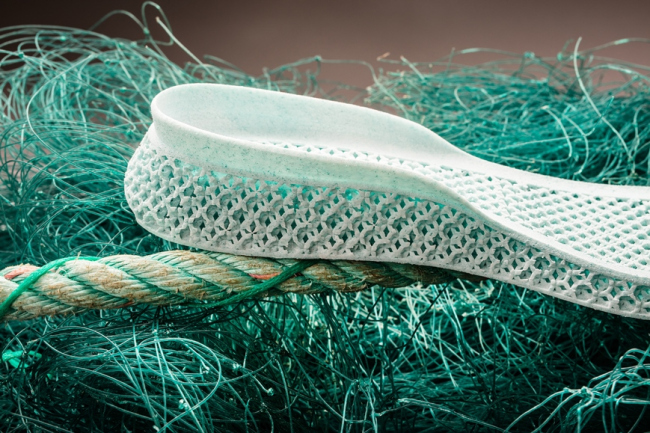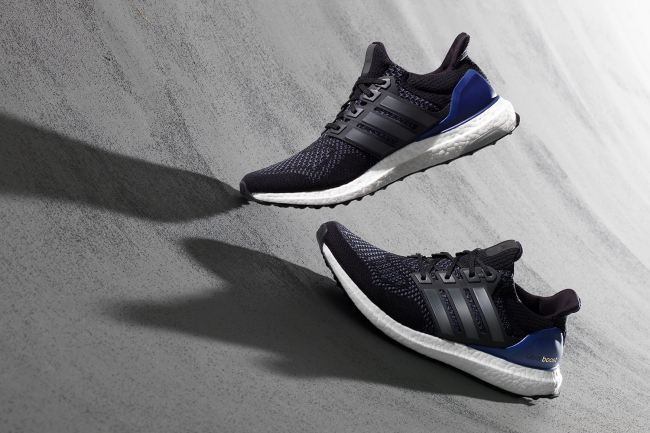[Weekender] Sneaker dissected: why so comfortable?
By Son Ji-hyoungPublished : July 12, 2018 - 15:33
It is the brand and design that can seem most alluring when making choices of sneakers or gym shoes.
But it is the evolving chemical technology that silently has led the popularity of shoes on rubber soles, pushing the limits of people every day from fitness enthusiasts to fashionistas on the streets.
But it is the evolving chemical technology that silently has led the popularity of shoes on rubber soles, pushing the limits of people every day from fitness enthusiasts to fashionistas on the streets.

The springy footwear has optimized the experience of runners and pedestrians alike, cushioning impact from the ground and returning energy to the legs when they strike the ground. Such means to stabilize human forward motions have helped maximize athletic performance and minimize risks of injury.
Behind the evolution were shoemakers’ trailblazing efforts in their decadeslong race for consumer comfort and pleasure.
And shoemakers believe there is still room for more consumer satisfaction ahead.
Each component of running shoes, mainly composed of various forms of foam, has explored its role in keeping runners and pedestrians safe and sound. Footwear in contemporary day stems from not only myriad combinations of shoe components, but also development of materials used in a single component.
Among all components -- from upper and sneaker tongue on top to outsole and gel cushioning on base -- the midsole sandwiched between has been considered a backbone of the shoe.
Behind the evolution were shoemakers’ trailblazing efforts in their decadeslong race for consumer comfort and pleasure.
And shoemakers believe there is still room for more consumer satisfaction ahead.
Each component of running shoes, mainly composed of various forms of foam, has explored its role in keeping runners and pedestrians safe and sound. Footwear in contemporary day stems from not only myriad combinations of shoe components, but also development of materials used in a single component.
Among all components -- from upper and sneaker tongue on top to outsole and gel cushioning on base -- the midsole sandwiched between has been considered a backbone of the shoe.

Since the mid-1980s, a history of sneakers evolution moves abreast of a technology innovation of the midsole.
Research to develop a midsole that returns an optimal amount of energy to the legs gave birth to synthetic rubber compounds like ethylene vinyl acetate and polyurethane. The materials were used as for the foam that constitutes the midsole.
Global shoemaker juggernauts like Germany’s Adidas and the US’ Nike have come up with their own brands of midsoles for running shoes.
Another branch of midsole evolution was the ultrathin sole made of thermoplastic polyurethane that emerged in the late 2000s. Sneakers using TPU midsoles do not need an external sole, and are made for activities like beach soccer, yoga or Pilates.
Midsoles have also been 3-D printed, so that the shape is tailored to an individual consumer’s foot contours. Adidas since the mid-2010s has created FutureCraft 4D shoes for customers.
Research to develop a midsole that returns an optimal amount of energy to the legs gave birth to synthetic rubber compounds like ethylene vinyl acetate and polyurethane. The materials were used as for the foam that constitutes the midsole.
Global shoemaker juggernauts like Germany’s Adidas and the US’ Nike have come up with their own brands of midsoles for running shoes.
Another branch of midsole evolution was the ultrathin sole made of thermoplastic polyurethane that emerged in the late 2000s. Sneakers using TPU midsoles do not need an external sole, and are made for activities like beach soccer, yoga or Pilates.
Midsoles have also been 3-D printed, so that the shape is tailored to an individual consumer’s foot contours. Adidas since the mid-2010s has created FutureCraft 4D shoes for customers.

To Adidas, an upper edge in midsole technology against sportswear market leader Nike translates into a chance to narrow the gap between the two.
Adidas launched Boost, a product line using an expanded TPU-based midsole, by teaming up with German chemical company BASF in 2013. This boosted Adidas’ yearly revenue in 2017 by some 27 percent on-year in the North American market, compared to 3 percent rise for Nike in 2017 and Adidas’ increase of just 2 percent in 2013.
By Son Ji-hyoung
(consnow@heraldcorp.com)
Adidas launched Boost, a product line using an expanded TPU-based midsole, by teaming up with German chemical company BASF in 2013. This boosted Adidas’ yearly revenue in 2017 by some 27 percent on-year in the North American market, compared to 3 percent rise for Nike in 2017 and Adidas’ increase of just 2 percent in 2013.
By Son Ji-hyoung
(consnow@heraldcorp.com)







![[KH Explains] Hyundai's full hybrid edge to pay off amid slow transition to pure EVs](http://res.heraldm.com/phpwas/restmb_idxmake.php?idx=644&simg=/content/image/2024/04/18/20240418050645_0.jpg&u=20240419100350)







![[From the Scene] Monks, Buddhists hail return of remains of Buddhas](http://res.heraldm.com/phpwas/restmb_idxmake.php?idx=652&simg=/content/image/2024/04/19/20240419050617_0.jpg&u=20240419175937)

![[KH Explains] Hyundai's full hybrid edge to pay off amid slow transition to pure EVs](http://res.heraldm.com/phpwas/restmb_idxmake.php?idx=652&simg=/content/image/2024/04/18/20240418050645_0.jpg&u=20240419100350)

![[Today’s K-pop] Illit drops debut single remix](http://res.heraldm.com/phpwas/restmb_idxmake.php?idx=642&simg=/content/image/2024/04/19/20240419050612_0.jpg&u=)